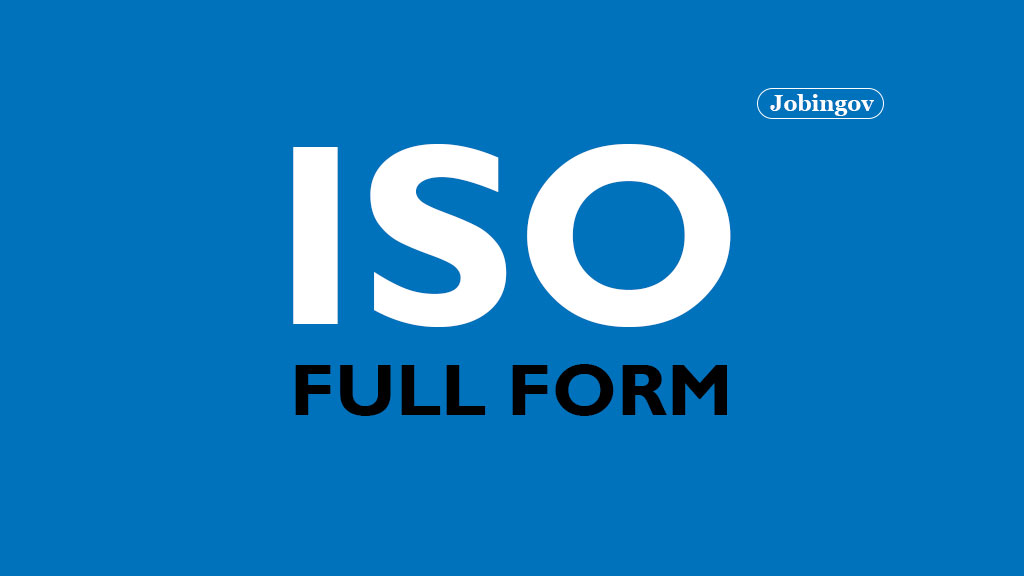International Organization for Standardization is the full form of ISO. It is to be noted that the term “ISO” is evaluated from the Greek word “isos” which means “equal”.
It sets the international standard containing representative from different standard organization at national level. ISO checks all the system of management, manufacturing process, service, or documentation procedure that are essential to standardize and assurance of quality.

ISO is an independent, non-governmental, international organization that always make development to make sure the various parameters such as quality, safety, products’ efficiency, services and systems.
They prepare guidelines and standards of various business and publish their technical reports. This organization make promotion at international level of their proprietary, industrial and commercial standards.
Presently, number of standards is around 19500 that the ISO has published which controls each and every industry, technology, food safety, agriculture and healthcare with 165 country members.
- Headquarter: Geneva, Switzerland
- Year of Establishment: On 23rd February 1947, London, United Kingdom
- Present President: Eddy Njoroge
- Type of Organization: Non-governmental organization
- Members of Founders: International Federation of the National Standardizing Associations, United Nations Standards Coordinating Committee.
- Official Languages: English, French and Russian
History of Formation
Around 1920s, ISO was started with the name of ISA (International Association of National Standardizing Associations) but in 1942, at the time of world war II, it was discontinued.
Just after the war, in 1947, with the delegation of 25 countries at the Institute of Civil Engineers in London determine to set up an organization at international level that makes international coordination and unification of various industries’ standardization easy.
In 1947, in the month of February, officially announced for the establishment of ISO and started its operation. Their main aim is to deliver products to the consumers with top quality.
Benefits of the ISO Certification
- Employees are measured, organized and clarified in detail with the selected procedure.
- Training to the new employees will be very easy.
- Problems can be detected at the initial level and a strong solution can be prepared.
- Loyalty of the consumers can be improved.
- Clients requirements can be understood.
- You are very much confident with your business profile.
- Improvement of relationship with suppliers strengthened.
- Connectivity with the people increases.
- Employees have clear understanding about the company.
- It will help to increase the involvement of employees.
Related Full Forms:
Different Standard Published by ISO
Till now, ISO has published around 22,000 standards with their related documents. Below, we have mention some popular standard such as:
ISO 9000 – QUALITY MANAGEMENT:
In this section, there contain ISO 9000:2015 (Fundamentals and vocabulary are mentioned), ISO 9001 (various requirements are mentioned), ISO 9004 (provide guidance to meet highest quality), and ISO 19011 (provide guideline for the management system of auditing).
ISO 14000 – ENVIRONMENTAL MANAGEMENT:
In this family, there contain ISO 14001 (required guidance for the environment management mentioned), ISO 14004:2016 (guidelines for the implementation are mentioned), and ISO 14005:2019 (some flexible guidelines for the phase-wise implementation is provided).
- ISO 13485 – Provided for the Medical Devices
- ISO/IEC 17025 – Provided for the testing and calibration of the laboratories equipment.
- ISO 22000 – Provided for the Food Safety Management.
- ISO 26000 – Provided for the Social Responsibility.
- ISO 31000 – Provided for the Risk Management.
- ISO 37001 – Provided for the Anti Bribery Management System.
- ISO 45001 – Provided for the Occupational Health and Safety.
- ISO 50001 – Provided for the Energy Management.
- ISO/IEC 27001 – Provided for the Information Security Management.
Definition of ISO 9001
The certification of ISO 9001: 2008 has three components such as ISO, 9001, and 2015. Here, we have discussed the explanation of these three components.
ISO:
ISO is an organization at international level that facilitates standardization for international organization. It sets up various standards to provide certification to the various organization across the world. They check all the parameter each year that is handled by a third-party.
9001:
This is a number written after the ISO mark. The term “ISO 9000” indicates the family of quality management. It is considered that the quality of ISO 9001 is the highest standards and follows the quality management principle during production. Through this certification, customers become more satisfied and reliable to the service provider or organization.
2015:
This number written at the last of the ISO certification that indicates on which year the standards were launched. The number 2015 refers the edition of ISO 9001 that is fifth. In 2015, in the month of September, these standards were launched and modified its process to achieve the highest quality specification.
Read More:
Conclusion
We hope this post will help you to know about the ISO Full Form, History, Benefits, Different standard, Definition of ISO 9001, etc. For more Full Form like this visit this website regular basis. Also, you can follow us on Facebook and Twitter to get latest post notification immediately.
Frequently Asked Questions
Q1. What is the full form of ISO?
Ans: The full form of ISO is International Organization for Standardization.
Q2. How much I have to pay for ISO certification?
Ans: There is no fixed amount for ISO certification. Depending on the various parameters such as copies of standards, fees of consultant’s and many more, and varies from organization to organization. The cost of ISO certification is also varying from companies to companies according to their type.
Q3. When was the ISO established?
Ans: ISO was established on 23rd February 1947.
Q4. What are the official languages of ISO?
Ans: English, French and Russian are the official languages of ISO.
Q5. Where is the headquarter of ISO?
Ans: The headquarter of ISO is situated in Geneva, Switzerland.
Q6. What does the ISO 14000 indicate?
Ans: ISO 14000 that the guidance is provided for environment management by ISO to the specific organization.





